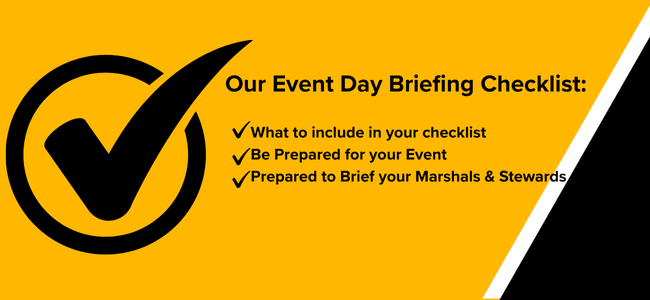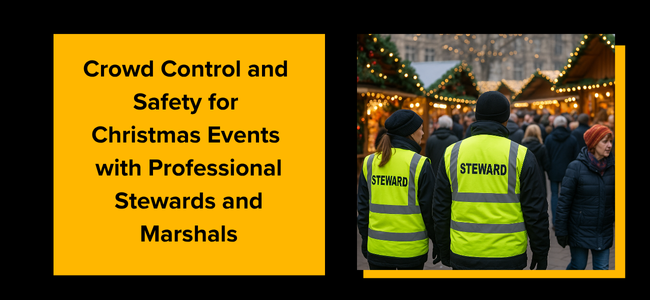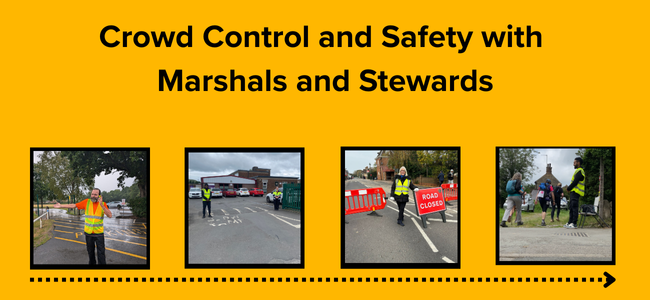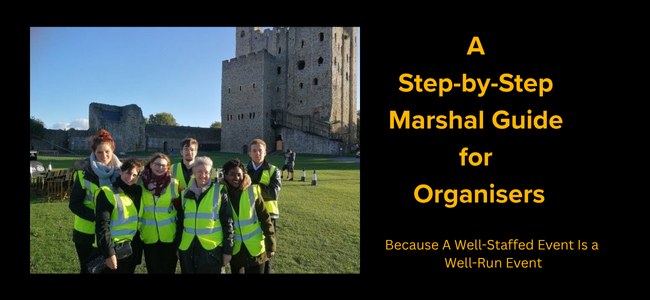Crowd Control and Safety for Christmas Events with Professional Stewards and Marshals The festive season…

Why Every Event Needs an Event Day Briefing Checklist for Staff and Stewards
Why Every Event Needs an Event Day Briefing Checklist for Staff and Stewards
Planning a major event is a logistical feat—but the real test comes on event day. Whether you’re managing an outdoor music festival, an indoor exhibition, or a large-scale conference, having your team prepared and properly briefed is essential to a safe and successful operation.
That’s where the Event Day Briefing Checklist becomes an indispensable tool. It ensures all marshals, stewards, and on-site staff receive consistent, relevant information ahead of time. This not only helps things run smoothly but also reinforces safety protocols, professional standards, and effective crowd management.
In this blog, we explain why every organiser should adopt a robust briefing checklist, especially when working with event staff, and what exactly it should include.
Why an Event Day Briefing Checklist Is Crucial
With so many moving parts on event day—vendors, performers, production crews, VIPs, and the general public—it’s easy for details to get lost. A structured checklist gives clarity and confidence to everyone involved. Here’s why it’s so important:
Team Alignment: Ensures all staff, stewards, and marshals receive consistent instructions, reducing misunderstandings.
Professional Standards: Helps demonstrate that you take operations and staff coordination seriously.
Quick Response: Gives teams the tools and knowledge to respond quickly to unexpected situations.
Risk Management: Reinforces compliance with safety, legal, and insurance requirements.
Operational Efficiency: Speeds up team deployment and reduces downtime at the start of the day.
Whether you’re the event organiser or a staffing provider, a briefing checklist makes your operation more robust and your event more professional.
Key Items to Include in Your Event Day Briefing Checklist
Let’s take a closer look at what your checklist should include to deliver a comprehensive and effective team briefing.
1. Team Briefing Time & Location
Your checklist must include the time and place for the team to assemble before deployment. Be specific:
State the exact arrival time for staff.
Provide a clearly described briefing point or muster area.
Name the person leading the briefing.
Indicate how long the session is expected to last.
This ensures the day starts on a well-organised note. If you have a large crew, consider staggering briefings by zone or role.
2. Radio Distribution & Channel Assignments
Radios are vital for real-time communication across large or complex sites. Your checklist should confirm:
Radios are distributed and working.
Each person knows their radio channel.
Emergency or supervisor channels are clearly identified.
Everyone understands radio etiquette, such as using clear, short messages.
A laminated channel guide or simple handout can help staff remember key information during the day.
3. Emergency Protocols & Response Plans
No event is risk-free. Staff must be briefed on how to handle emergencies, including:
Fire safety and evacuation routes.
Locations of first aid points and trained medical responders.
What to do if a lost child or vulnerable person is found.
How and when to escalate incidents and who to contact.
Response procedures for extreme weather (for outdoor events).
Staff should be clear on their role in emergencies and know who has final decision-making authority.
4. High-Risk Area Overview
Certain parts of the site may carry higher risks due to foot traffic, layout, or activities. Identify and explain:
Pinch points or narrow walkways.
Areas around stages, scaffolding or technical equipment.
Licensed zones where alcohol is served.
Entrances and exits likely to experience congestion.
Vehicle access routes (e.g., for delivery or crew vehicles).
Deploy experienced staff to these areas and ensure regular check-ins during the event.
5. Site Orientation & Marshal & Steward Roles
Every staff member should know:
Their exact position or patrol area.
How to get to their post.
The overall site layout, including toilets, lost property, medical points, and information desks.
Who their direct supervisor is.
The schedule of key moments (e.g., stage times, guest arrival windows, closing times).
Providing a printed or digital map helps immensely, especially for new team members or complex layouts.
6. Welfare & Break Information
Happy staff make for a better event. Your checklist should include:
Break schedules and durations.
Location of welfare zones, food stations, and toilets.
The process for checking in/out of breaks or at the end of the shift.
Availability of water and PPE if needed (particularly in hot weather or outdoor settings).
When staff feel looked after, they are more likely to stay alert and engaged throughout their shift.
7. Event-Specific Notes
No two events are the same. Make sure to include key briefing notes that relate to this specific event, such as:
High-profile attendees or VIPs.
Known crowd demographics (e.g., families, students, corporate guests).
Areas off-limits to general staff.
Any known concerns or incidents from previous years or setups.
Timings that may affect staffing, like major acts or scheduled announcements.
This section can be updated quickly for each new event and helps tailor the briefing to the day ahead.
Make Briefing Checklists Part of Your Event DNA
An Event Day Briefing Checklist is far more than an admin exercise—it’s a foundation for success. It supports staff clarity, guest safety, and overall operational flow. For clients hiring marshals and stewards, it also proves your professionalism and commitment to smooth delivery.
Our experience across festivals, exhibitions, and conferences has shown time and again that events with structured briefings have fewer incidents, better guest satisfaction, and more confident staff. This tool isn’t just “nice to have”—it’s essential.
So, as your next event approaches, make sure your team briefing is more than a huddle and a few words. Equip your staff with the information they need to deliver a safe, smooth and professional experience—and let your checklist do the heavy lifting. For more help and advice contact us at Marshals and Stewards.


